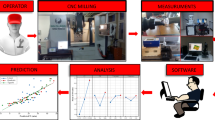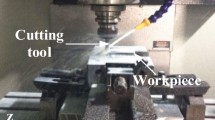Abstract
Cutting temperature always highly reaches to over 1,000°C during high speed. Diffusion of tool material element may have important influence on tool wear at such high temperature. The advanced ceramic cutting tools have very good wear resistance, high refractoriness, good mechanical strength, and hot hardness. In this paper, the rules of diffusion wear for alumina-based ceramic cutting tools are proposed and analyzed based on thermodynamics theory. Dissolution concentrations in typical normal workpiece materials of ceramic tool materials at different temperatures are then calculated. Diffusion reaction rules in high temperature are developed and analyzed using Gibbs free energy criterion. The machining tests were conducted using the alumina-based composite ceramic tools at different cutting speeds of 10, 150, and 250 m/min, feed of 0.2 and 0.3, and depth of cut of 1, 2, 2.5, and 5 mm, respectively, on PUMA300LM numerically controlled lathe. It was found that the theoretical results were uniform with the experimental data; the results will provide useful references for tool material design and selection.
Similar content being viewed by others
References
Chunyan XIA (2006) Ceramic material and application of high speed machining. Coal Technology 25:8–10
Senthil Kumar A, Raja Durai A, Sornakumar T (2006) Wear behaviour of alumina based ceramic cutting tools on machining steels. Tribol Int 39:191–197
Silva LR, Abrao AM (1999) Machining of the hardened AISI 4340 steel using ceramic and PCBN tooling. Sci Eng J 8:85–92
Brandt G (1999) Ceramic cutting tools, state of the art and development trends. Mater Technol 14:17–22
Liu Y (1989) Metal cutting theory and tools. Working Personnel Press, Beijing
Buljan ST, Wayne SF (1989) Wear and design of ceramic cutting tool materials. Wear 133:309–321
Buljan ST, Wayne SF (1987) Silicon nitride-based composites. Composites 18:99–106
Baldoni JG, Wayne SF, Buljan ST (1986) Cutting tool materials: mechanical properties–wear-resistance relationships. ASLE Trans 29:347–352
Wan Y, Ai X, Liu Z, Song L (2007) Tool wear and fracture in high speed milling aluminum alloy 7050-T7451. Chinese Journal of Mechanical Engineering 43:103–108
Tonshoff HK, Bartsch S (1988) Performance of ceramic cutting tool materials in dependence on their specific properties. American Society of Mechanical Engineers (ASME), New York, pp 229–241
Silva RF, Gomes JM, Miranda AS, Vieira JM (1991) Resistance of Si3N4 ceramic tools to thermal and mechanical loading in cutting of iron alloys. Wear 148:69–89
Yeomans JA, Page TF (1989) The chemical stability of ceramic cutting tool materials exposed to liquid metals. Wear 131:163–175
Vleugels J, Jacobs P, Kruth JP, Vanherck P, DuMong W, Van Der Biest O (1995) Machining of steel with sialon ceramics: influence of ceramic and workpiece composition on tool wear. Wear 189:32–44
Lo Casto S, Lo Valvo E, Ruisi VF, Lucchini E, Maschio S (1993) Wear mechanism of ceramic tools. Wear 160:227–235
Silva RF, Oliveira FJ, Castro FP, Vieira JM (1998) Modeling of chemical wear in ferrous alloys/ silicon nitride contacts during high speed cutting. Acta Mater 46:2501–2507
Kannatey-Asibu EJ (1990) On the performance of a silicon nitride cutting tool in machining steel. Manuf Syst 9:159–168
Kramer BM, von Turkovich BF (1986) A comprehensive tool wear model. CIRP Annals Manufacturing Technology 35:67–70
Vleugels J, Van Der Biest O (1994) Development, characterization and oxidation behaviour of Si3N4–Al2O3 ceramics. J Eur Ceram Soc 13:529–544
Dai Z, Wang M, Xue Q (2002) Introduction to tribo-thermodynamics. National Defence Industry Press, Beijing
Taminiau DA, Dautzenberg JH (2005) How to understand friction and wear in mechanical working process. Wear 25:62–65
Ye D, Hu J (2002) Practical mineral thermodynamics data notebook. Metallurgy Industry Press, Beijing
Chen Z (2005) Chemical thermodynamics and fire-resistant. Material Metallurgy Industry Press, Beijing
Wong T, Kim W, Kwon P (2004) Experimental support for a model-based prediction of tool wear. Wear 257:790–798
Zhou Z (1992) Metal cutting theory. Mechanical Industry Press, Beijing
Hao S (2004) Material thermodynamics. Chemical Industry Press, Beijing
Cheng D (1993) Mechanical design handbook, vol I. Chemical Industry Press, Beijing
Author information
Authors and Affiliations
Corresponding author
Rights and permissions
About this article
Cite this article
Shao, F., Liu, Z. & Wan, Y. Thermodynamical matching of alumina-based composite ceramic tools with typical workpiece materials. Int J Adv Manuf Technol 49, 567–578 (2010). https://doi.org/10.1007/s00170-009-2413-0
Received:
Accepted:
Published:
Issue Date:
DOI: https://doi.org/10.1007/s00170-009-2413-0




